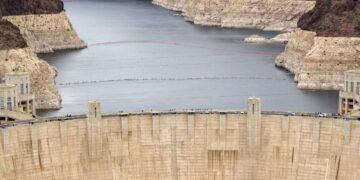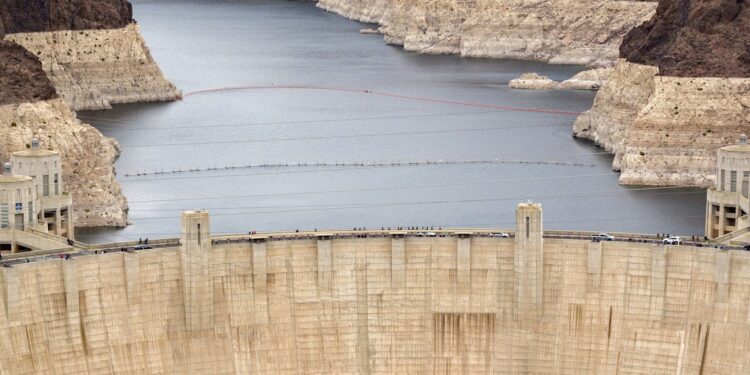Login to Continue Learning
The Colorado River is in crisis. Its water supply does not meet the demand from users, including agriculture, power generation, recreation, habitat for wildlife, and drinking water for major cities across multiple states and even beyond the basin.
– **Usage**: The river supports about 5 million acres of farmland, provides hydroelectric power to millions, and serves critical habitats. Thirty Native American tribes assert rights to Colorado River water.
– **Urban Use**: It is a vital source of drinking water for cities within the Colorado River Basin, such as Phoenix, Tucson, and Las Vegas, and for cities outside the basin like Los Angeles, San Diego, Salt Lake City, Denver, and Albuquerque.
For over 25 years, states in the Colorado River Basin have been trying to manage declining supplies. They revised usage guidelines and implemented additional measures due to persistent drought and reservoir level declines. Current guidelines will expire by late 2026, but negotiations on new ones are stalled because of disagreements on how to avoid future crises.
In June 2025, Arizona proposed a new approach that would base water availability on actual river flows rather than projections or historical allocations. While praised for offering “a glimmer of hope,” this proposal presents daunting challenges for agreement among the Basin states.
#### The Colorado River Compact
The 1922 Colorado Compact divided the basin into Upper and Lower Basins, with each allocated 7.5 million acre-feet annually. An acre-foot is enough to cover one acre in water one foot deep (about 326,000 gallons) and can supply a single family for a year.
– **Sharing**: The compact specified that Mexico should be supplied first with any surplus, with the Upper and Lower Basins sharing equally any additional needs.
– **Delivery Obligation**: The Lower Basin states claim this is a “delivery obligation,” requiring the Upper Basin to ensure at least 75 million acre-feet flows over a decade. However, the Upper Basin contends it’s merely a “non-depletion obligation” capping their use.
#### A Small Source Area
Nearly all of the Colorado River’s water comes from snow in the Rocky Mountains’ Upper Basin, which covers only 15% of the basin’s surface area. Most of the rest of the basin is arid or semi-arid and contributes little to river flows.
– **Varying Precipitation**: Rain and snowfall vary dramatically each year, so reservoirs were built to store water during wet years for use in dry ones. Key reservoirs include Lake Mead (Hoover Dam) and Lake Powell (Glen Canyon Dam).
– **Drought Impact**: Over the past 25 years, these reservoirs have lost significant water due to a prolonged drought possibly exacerbated by climate change. Studies suggest this may be one of the driest periods in 1,200 years.
#### Human Errors
Compact negotiators made unrealistic assumptions about average river flows and ignored available data, likely knowingly. Additionally, the current system does not account for roughly 1.3 million acre-feet annually lost from evaporation or seepage in Lake Mead.
– **Evaporation**: This accounts for steady declines in Lake Mead’s water level even under normal operations.
#### Stabilization Efforts
To stabilize reservoirs, states and Mexico agreed to new guidelines in 2007 and additional measures in 2019. These included coordinated releases from Upper Basin reservoirs and reductions in Lower Basin usage depending on Lake Mead levels.
– **Recent Reductions**: In 2023, Arizona, California, and Nevada used their lowest combined annual consumption since 1983 (5.8 million acre-feet), with the Lower Basin slightly higher at 6.09 million acre-feet in 2024.
#### A New Opportunity?
With existing agreements expiring in 2026, states are negotiating a new approach. Arizona’s proposal of supply-driven water availability offers hope but faces significant details to be resolved. If negotiations fail, the Interior Secretary could decide on reservoir balancing and deliveries, likely leading to legal challenges.
– **Court Disputes**: The Lower Basin states are prepared to enforce their interpretation of the Upper Basin’s “delivery obligation,” which the Upper Basin disputes.
– **Uncertainty for Users**: Farmers in Arizona’s Yuma County and California’s Imperial County face uncertainty about water supplies. Municipal providers worry about meeting demands, and tribal nations fear insufficient water for their communities.
The Colorado River’s future is uncertain as states navigate these complex challenges.


















